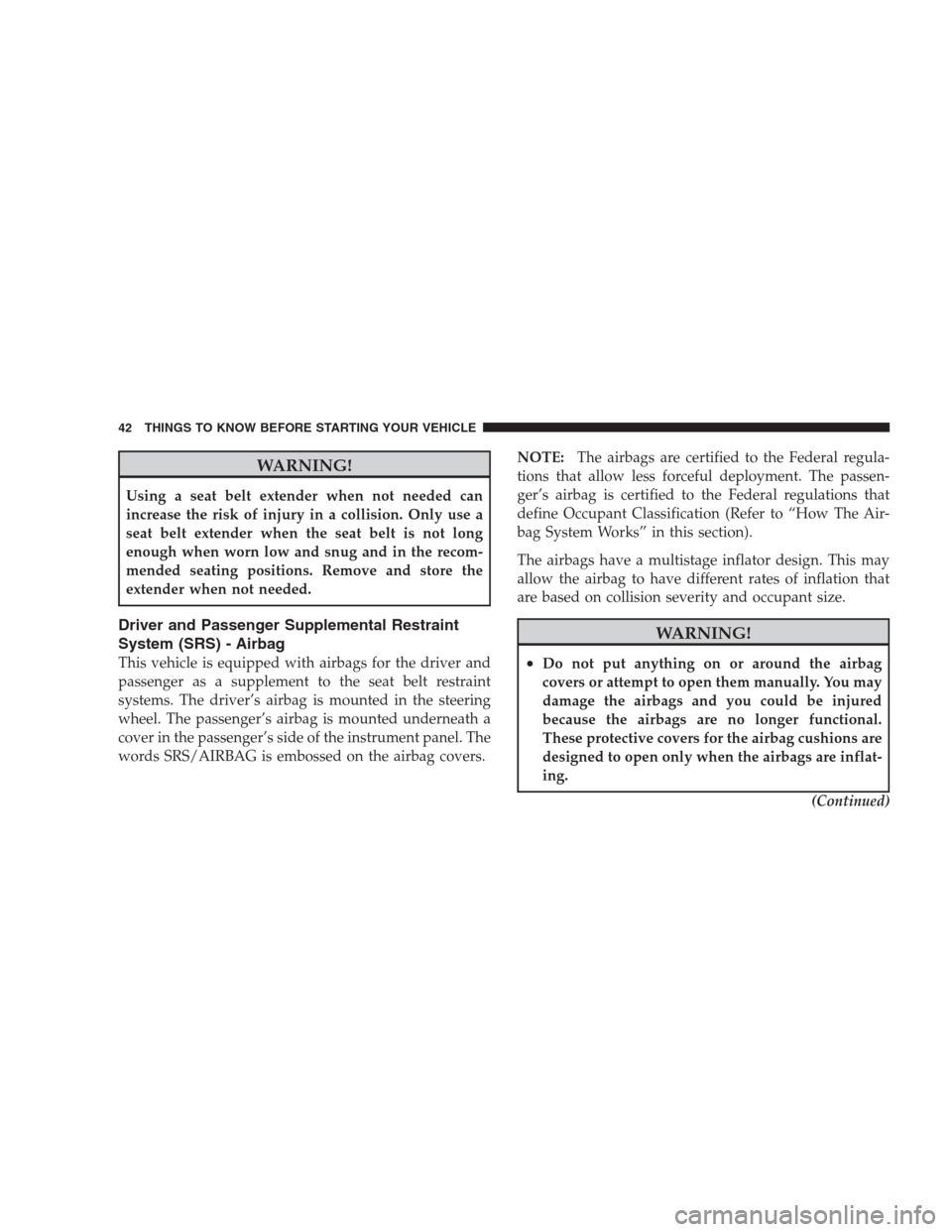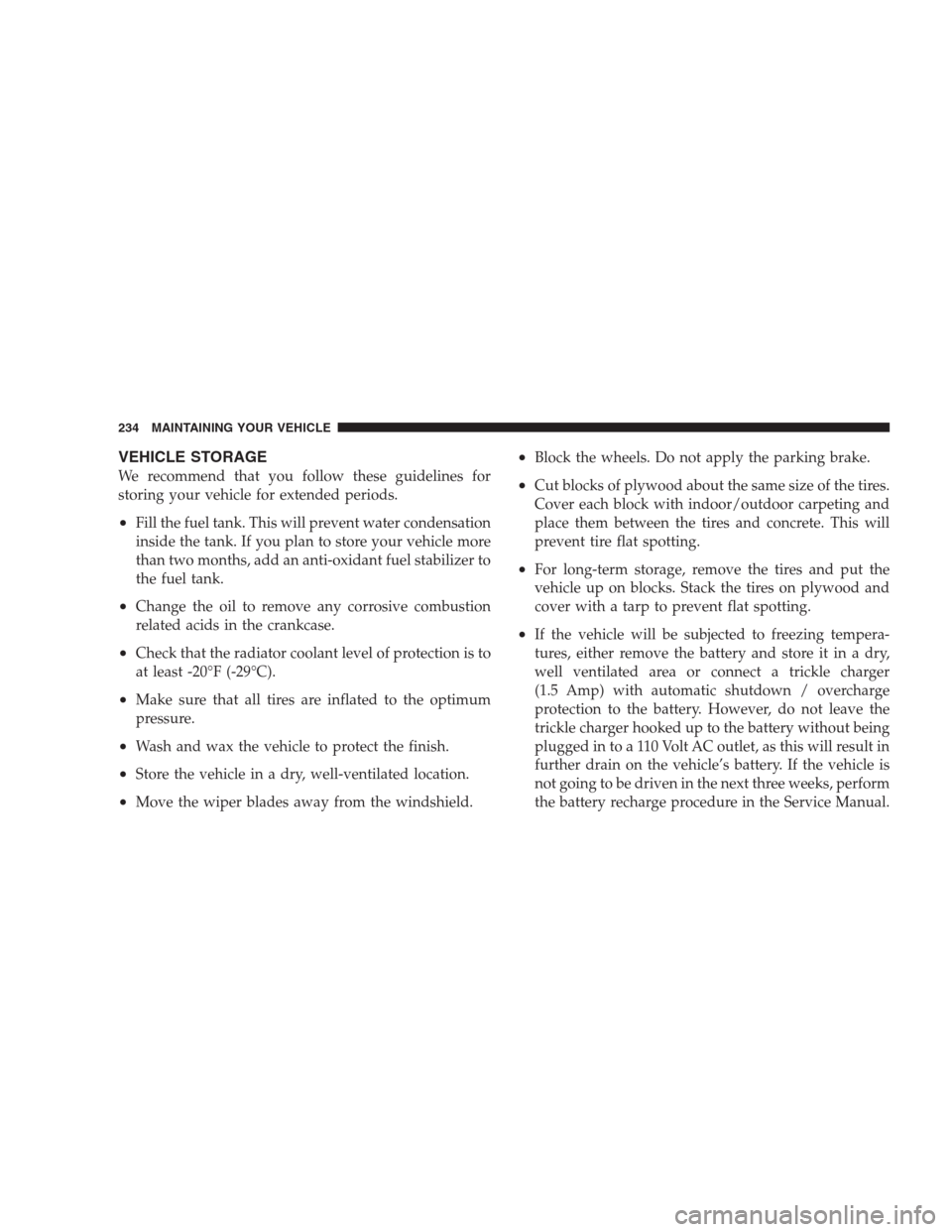2009 DODGE VIPER wheel size
[x] Cancel search: wheel sizePage 44 of 299

WARNING!
Using a seat belt extender when not needed can
increase the risk of injury in a collision. Only use a
seat belt extender when the seat belt is not long
enough when worn low and snug and in the recom-
mended seating positions. Remove and store the
extender when not needed.
Driver and Passenger Supplemental Restraint
System (SRS) - Airbag
This vehicle is equipped with airbags for the driver and
passenger as a supplement to the seat belt restraint
systems. The driver’s airbag is mounted in the steering
wheel. The passenger’s airbag is mounted underneath a
cover in the passenger’s side of the instrument panel. The
words SRS/AIRBAG is embossed on the airbag covers.NOTE:The airbags are certified to the Federal regula-
tions that allow less forceful deployment. The passen-
ger’s airbag is certified to the Federal regulations that
define Occupant Classification (Refer to “How The Air-
bag System Works” in this section).
The airbags have a multistage inflator design. This may
allow the airbag to have different rates of inflation that
are based on collision severity and occupant size.
WARNING!
•Do not put anything on or around the airbag
covers or attempt to open them manually. You may
damage the airbags and you could be injured
because the airbags are no longer functional.
These protective covers for the airbag cushions are
designed to open only when the airbags are inflat-
ing.
(Continued)
42 THINGS TO KNOW BEFORE STARTING YOUR VEHICLE
Page 49 of 299

WARNING!
Ignoring the Airbag Warning Light in your instrument
panel could mean you won’t have the airbags to protect
you in a collision. If the light does not come on, stays
on after you start the vehicle, or if it comes on as you
drive, have the airbag system checked right away.
•TheDriver Airbag/Inflator Unitis mounted in the
steering wheel. ThePassenger Airbag/Inflator Unitis
mounted underneath a cover in the passenger side of
the instrument panel. When the ORC detects a colli-
sion requiring the airbags, it signals the inflator units.
A large quantity of non-toxic gas is generated to inflate
the airbags. Different airbag inflation rates may be
possible based on collision severity and occupant size.
The steering wheel hub trim cover and the upper right
side of the instrument panel separate and then fold out
of the way, as the bags inflate to their full size. Thebags inflate fully in about 50 to 70 ms. This is about
half of the time it takes to blink your eyes. The bags
then deflate quickly while helping to restrain the
driver and passenger. The airbag gas is vented toward
the instrument panel through vent holes in the airbag
material. In this way, the airbags do not interfere with
your control of the vehicle.•TheKnee Impact Bolstershelp protect the knees of
the driver and the passenger, and position everyone
for the best interaction with the airbags.
•TheOccupant Classification Module (OCM)is lo-
cated underneath the passenger seat. The OCM uses
input from the Flex Mat to classify the occupant in the
passenger seat into a size category. The OCM commu-
nicates this information to the ORC. The ORC may
modify the rate of passenger airbag inflation or pre-
vent passenger airbag deployment based on occupant
classification.
THINGS TO KNOW BEFORE STARTING YOUR VEHICLE 47
2
Page 108 of 299

Your vehicle has also been equipped with a TPMS
malfunction indicator to indicate when the system is not
operating properly. The TPMS malfunction indicator is
combined with the low tire pressure telltale.
When the system detects a malfunction, the telltale will
flash for approximately one minute and then remain
continuously illuminated. This sequence will continue
upon subsequent vehicle start-ups as long as the mal-
function exists. When the malfunction indicator is illumi-
nated, the system may not be able to detect or signal low
tire pressure as intended.
TPMS malfunctions may occur for a variety of reasons,
including the installation of replacement or alternate tires
or wheels on the vehicle that prevent the TPMS from
functioning properly. Always check the TPMS malfunc-
tion telltale after replacing one or more tires or wheels onyour vehicle to ensure that the replacement or alternate
tires and wheels allow the TPMS to continue to function
properly.
CAUTION!
The Tire Pressure Monitor System (TPMS) has been
optimized for the original equipment tires and
wheels. The TPMS pressures have been established
for the tire size equipped on your vehicle. Undesir-
able operation or sensor damage may result when
using replacement equipment that is not of the same
size, type, and/or style. Aftermarket wheels can cause
sensor damage. Do not use aftermarket tire sealants
or balance beads if your vehicle is equipped with the
TPMS, as damage to the sensors may result.
106 UNDERSTANDING YOUR INSTRUMENT PANEL
Page 152 of 299

WARNING! (Continued)
•Pumping of the Anti-Lock Brakes will diminish
their effectiveness and may lead to an accident.
Pumping makes the stopping distance longer. Just
press firmly on your brake pedal when you need
to slow down or stop.
•Anti-lock system (ABS) cannot prevent the natural
laws of physics from acting on the vehicle, nor can
it increase braking or steering efficiency beyond
that afforded by the condition of the vehicle
brakes and tires or the traction afforded.
•The ABS cannot prevent accidents, including
those resulting from excessive speed in turns,
following another vehicle too closely, or hydro-
planing. Only a safe, attentive, and skillful driver
can prevent accidents.
(Continued)
WARNING! (Continued)
•The capabilities of an ABS equipped vehicle must
never be exploited in a reckless or dangerous
manner, which could jeopardize the user’s safety
or the safety of others.
All vehicle wheels and tires must be the same size and
type as the original equipment and the tires must be
properly inflated to produce accurate signals for the
computer.
WARNING!
Significant over- or under-inflation of tires, or mix-
ing sizes of front or rear tires or wheels on the vehicle
can lead to loss of braking effectiveness.
150 STARTING AND OPERATING
Page 168 of 299

Replacement Tires
The tires on your new vehicle provide a balance of many
characteristics. They should be inspected regularly for
wear and correct cold tire inflation pressure. The manu-
facturer strongly recommends that you use tires equiva-
lent to the originals in size, quality and performance
when replacement is needed. (Refer to the paragraph on
“Tread Wear Indicators”). Refer to the “Tire and Loading
Information” placard for the size designation of your tire.
The service description and load identification will be
found on the original equipment tire. Failure to use
equivalent replacement tires may adversely affect the
safety, handling, and ride of your vehicle. We recommend
that you contact your original equipment or an autho-
rized tire dealer with any questions you may have on tire
specifications or capability.WARNING!
•DO NOT use a tire, wheel size or rating other than
that specified for your vehicle. Some combinations
of unapproved tires and wheels may change sus-
pension dimensions and performance characteris-
tics, resulting in changes to steering, handling, and
braking of your vehicle. This can cause unpredict-
able handling and stress to steering and suspen-
sion components. You could lose control and have
an accident resulting in serious injury or death.
Use only the tire and wheel sizes with load ratings
approved for your vehicle.
•Never use a tire with a smaller load index or
capacity, other than what was originally equipped
on your vehicle. Using a tire with a smaller load
index could result in tire overloading and failure.
You could lose control and have an accident.
(Continued)
166 STARTING AND OPERATING
Page 169 of 299

WARNING! (Continued)
•Failure to equip your vehicle with tires having
adequate speed capability can result in sudden tire
failure and loss of vehicle control.
CAUTION!
Replacing original tires with tires of a different size
may result in false speedometer and odometer read-
ings.
Tire Storage
Tire storage is addressed in the Michelin Limited Tire
Warranty Booklet.
Specific recommendations on guidelines for long term
tire storage for this vehicle should be requested of the
Michelin Tire Corporation 1-800-433-6838.
TIRE CHAINS
Due to limited clearance, tire chains are not recom-
mended.
CAUTION!
Damage to the vehicle may result if tire chains are
used.
SNOW TIRES
There are no snow tires that are compatible with the
wheels on this vehicle.
TIRE ROTATION RECOMMENDATIONS
Tires on the front and rear axles of vehicles operate at
different loads and perform different steering, driving,
and braking functions. For these reasons, they wear at
unequal rates, and tend to develop irregular wear pat-
terns.
STARTING AND OPERATING 167
5
Page 171 of 299

TIRE PRESSURE MONITOR SYSTEM (TPMS)
Low Tire Indicator
If tire pressure falls below 23 psi (159 kpa), the Low Tire
Pressure Telltale in the Message Center will illuminate, a
chime will sound, and the words LOW TIRE will flash
slowly in the Liquid Crystal Display (LCD) panel in the
bottom of the speedometer. If tire pressure falls below
18 psi (124 kpa), the Low Tire Pressure Telltale will
illuminate, a chime will sound, and the words “FLAT
TIRE” will flash rapidly in the display. You should obtain
immediate service if the low tire indicator is activated.
NOTE:Each wheel on your vehicle contains a tire
pressure sensor. The TPMS learns the location of each
sensor though system programming. Although not re-
quired, the manufacturer recommends reprogramming
the TPMS after rotating the tires so that the system can
relearn each sensor ’s location. See your authorized dealer
for system reprogramming.
CAUTION!
The Tire Pressure Monitor System (TPMS) has been
optimized for the original equipment tires and
wheels. The TPMS pressures have been established
for the tire size equipped on your vehicle. Undesir-
able operation or sensor damage may result when
using replacement equipment that is not of the same
size, type, and/or style. Aftermarket wheels can cause
sensor damage. Do not use aftermarket tire sealants
or balance beads if your vehicle is equipped with the
TPMS, as damage to the sensors may result.
WARNING!
Do not exceed 55 mph (88 km/h) if the LOW Tire
indicator is activated. Vehicle handling and braking
may be reduced. You could have an accident and be
severely or fatally injured.
STARTING AND OPERATING 169
5
Page 236 of 299

VEHICLE STORAGE
We recommend that you follow these guidelines for
storing your vehicle for extended periods.
•Fill the fuel tank. This will prevent water condensation
inside the tank. If you plan to store your vehicle more
than two months, add an anti-oxidant fuel stabilizer to
the fuel tank.
•Change the oil to remove any corrosive combustion
related acids in the crankcase.
•Check that the radiator coolant level of protection is to
at least -20°F (-29°C).
•Make sure that all tires are inflated to the optimum
pressure.
•Wash and wax the vehicle to protect the finish.
•Store the vehicle in a dry, well-ventilated location.
•Move the wiper blades away from the windshield.
•Block the wheels. Do not apply the parking brake.
•Cut blocks of plywood about the same size of the tires.
Cover each block with indoor/outdoor carpeting and
place them between the tires and concrete. This will
prevent tire flat spotting.
•For long-term storage, remove the tires and put the
vehicle up on blocks. Stack the tires on plywood and
cover with a tarp to prevent flat spotting.
•If the vehicle will be subjected to freezing tempera-
tures, either remove the battery and store it in a dry,
well ventilated area or connect a trickle charger
(1.5 Amp) with automatic shutdown / overcharge
protection to the battery. However, do not leave the
trickle charger hooked up to the battery without being
plugged in to a 110 Volt AC outlet, as this will result in
further drain on the vehicle’s battery. If the vehicle is
not going to be driven in the next three weeks, perform
the battery recharge procedure in the Service Manual.
234 MAINTAINING YOUR VEHICLE